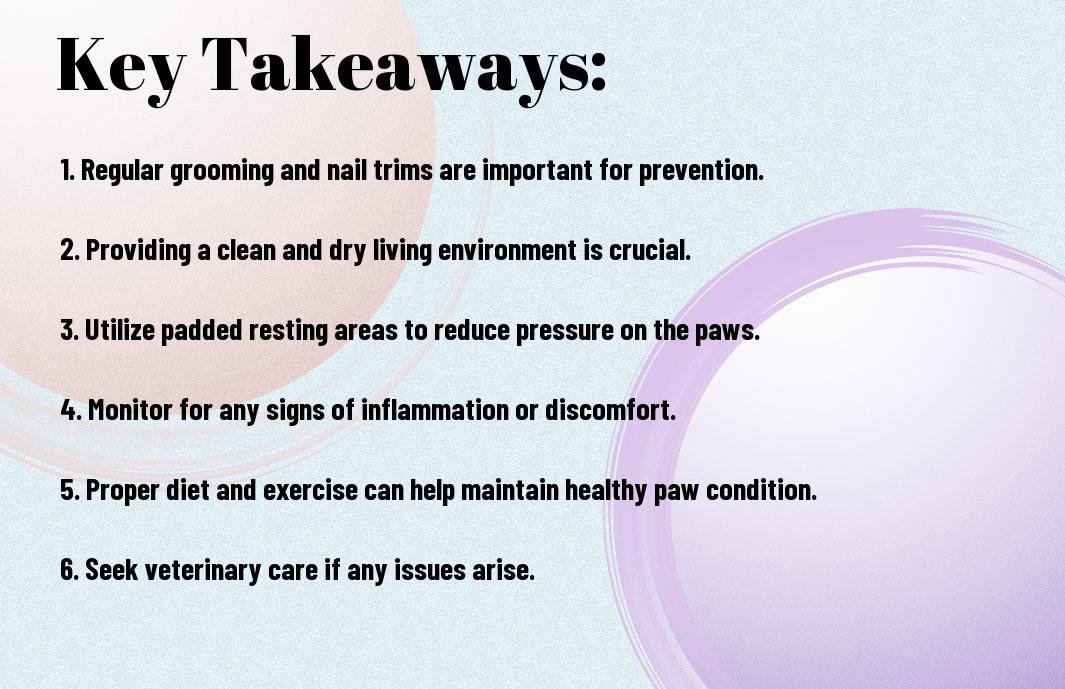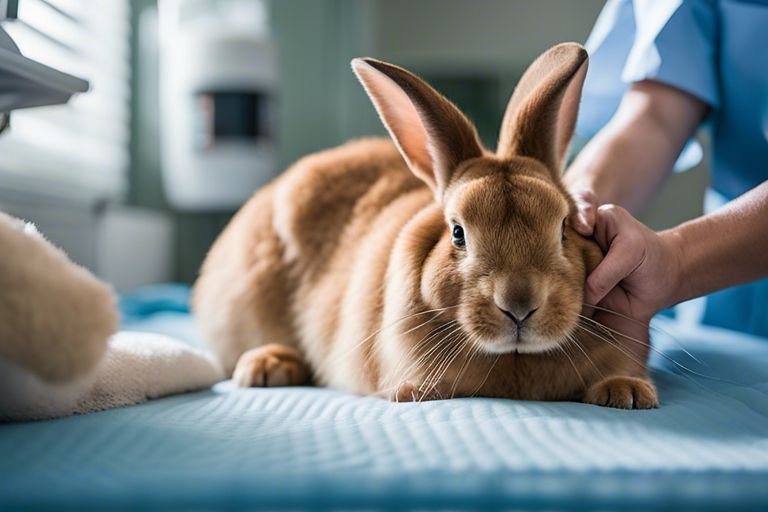Palmar pododermatitis, also known as sore hock, can be a serious and painful condition for Flemish Giant rabbits. As an owner, it is important for you to be proactive in preventing and managing this condition to ensure the health and well-being of your pet. In this blog post, we will discuss the specific preventive measures you can take to minimize the risk of pododermatitis in your Flemish Giant rabbit.
Key Takeaways:
- Paw Pododermatitis is a common condition in Flemish Giant rabbits: Due to their large size, Flemish Giant rabbits are prone to developing sore hocks, making preventive measures crucial to their overall health.
- Provide proper flooring and bedding: Maintaining a comfortable and padded living space for Flemish Giant rabbits can help prevent paw pododermatitis by reducing pressure on the hocks.
- Regular exercise and monitoring: Engaging in regular exercise and monitoring the rabbit’s weight can help prevent excessive pressure on the hocks, reducing the risk of paw pododermatitis.
- Diet management: Maintaining a balanced diet and preventing obesity in Flemish Giant rabbits can help reduce the risk of paw pododermatitis and other health issues.
- Regular grooming and foot care: Keeping the rabbit’s fur clean and its nails trimmed can help prevent infection and reduce the risk of paw pododermatitis.

Identifying Risk Factors
While paw pododermatitis can affect any rabbit breed, there are several risk factors that can increase the likelihood of this condition developing in your Flemish Giant rabbit.
- Obesity
- Poor ventilation in living environment
- Unsuitable flooring
- Inadequate grooming and hygiene
After identifying these risk factors, you can take the necessary steps to minimize their impact on your rabbit’s paw health.
Breed-Specific Vulnerabilities
It is important to recognize that Flemish Giant rabbits are particularly vulnerable to paw pododermatitis due to their large size and weight. The pressure exerted on their feet can lead to higher risk of developing this condition. Proper monitoring and preventive measures are crucial to minimize the impact of breed-specific vulnerabilities on your rabbit’s paw health.
Environmental and Lifestyle Influences
Your rabbit’s living environment and lifestyle play a significant role in the development of paw pododermatitis. Factors such as unsuitable flooring, inadequate grooming, and poor ventilation can contribute to the development of this condition. On the other hand, providing a spacious, clean living environment with appropriate flooring and regular grooming can significantly reduce the risk of paw pododermatitis in your Flemish Giant rabbit.
Preventive Measures for Pododermatitis
Now that you understand the risks and potential causes of paw pododermatitis in Flemish Giant rabbits, it’s important to discuss the specific preventive measures you can take to protect your rabbit from this painful condition. By implementing these measures, you can greatly reduce the likelihood of your rabbit developing pododermatitis and ensure their overall well-being.
Proper Housing and Bedding
One of the most crucial preventive measures for pododermatitis in Flemish Giant rabbits is to provide a proper housing environment with suitable bedding. You should ensure that your rabbit’s living space is spacious enough to allow for ample movement and exercise. Additionally, make sure that the flooring is not excessively hard or abrasive, as this can contribute to the development of pododermatitis. Instead, use soft, cushioned bedding that is gentle on your rabbit’s sensitive feet. Keep the bedding clean and dry at all times to prevent the accumulation of moisture, which can lead to bacterial infections and exacerbate pododermatitis.
Diet and Nutrition Optimization
Another critical aspect of preventing paw pododermatitis in Flemish Giant rabbits is to optimize their diet and nutrition. Ensure that your rabbit’s diet consists of a balanced blend of high-quality hay, fresh vegetables, and a controlled amount of pellets. A well-balanced diet is essential for maintaining overall health and ensuring that your rabbit’s immune system is strong enough to fend off potential infections. Additionally, proper nutrition can promote healthy skin and fur, which is essential for minimizing the risk of pododermatitis. Avoid any sudden changes in your rabbit’s diet, as this can disrupt their digestive system and potentially lead to nutritional deficiencies that may predispose them to paw problems.
Regular Paw Care and Monitoring
Despite the specific preventive measures for paw pododermatitis in Flemish Giant rabbits, regular paw care and monitoring are crucial in preventing and managing this condition. Paying close attention to your rabbit’s paws can help you detect any signs of pododermatitis early on, preventing it from progressing into a more severe condition. Regular monitoring involves checking the paws for any redness, swelling, or sores. It is essential to trim your rabbit’s nails regularly to prevent them from curling and putting pressure on the foot pads. Making sure that their living environment is clean and free from sharp or rough flooring is also important in preventing paw pododermatitis. For more detailed instructions on regular paw care and monitoring, you can refer to Paw-sitively Painful: A Complete Guide to Sore Hocks in Rabbits.
Hygiene Practices for Paw Health
Another essential aspect of preventing paw pododermatitis in Flemish Giant rabbits is maintaining good hygiene practices. This involves keeping your rabbit’s living space clean and dry, as damp bedding can contribute to the development of pododermatitis. Ensure that the flooring is soft and provides cushioning for your rabbit’s feet. Regularly spot clean their living area and change their bedding to prevent the build-up of harmful bacteria. Additionally, be mindful of any rough or sharp objects in their environment that could potentially injure their paws. By implementing these hygiene practices, you can significantly reduce the risk of paw pododermatitis in your rabbit.
The Role of Veterinarian Check-Ups
Regular check-ups with a veterinarian play a crucial role in preventing and managing paw pododermatitis in Flemish Giant rabbits. A veterinarian can provide guidance on proper nutrition, grooming, and environmental enrichment to promote healthy paw care. They can also conduct thorough examinations of your rabbit’s paws and provide treatment if any issues are identified. If you notice any changes in your rabbit’s paw health, such as redness, swelling, or sores, it is important to seek veterinary attention promptly. Early intervention can prevent the condition from worsening and improve your rabbit’s overall paw health. Your veterinarian can tailor a preventive care plan specific to your rabbit’s needs, ensuring optimal paw health and well-being.

Advanced Preventive Strategies
Lastly, let’s discuss some advanced preventive strategies to protect your Flemish Giant rabbit from paw pododermatitis. Here are some additional measures you can take to keep your rabbit’s feet healthy and pain-free:
- Use of Protective Footwear
- Innovative Treatments and Supplements
Use of Protective Footwear
When it comes to protecting your rabbit’s feet, using protective footwear can be an effective measure. There are specially designed booties available that can help reduce the pressure on your rabbit’s feet and prevent injuries. These booties are made from soft, breathable materials and can provide an extra layer of cushioning to protect your rabbit’s delicate paws. By using protective footwear, you can significantly reduce the risk of paw pododermatitis in your Flemish Giant rabbit.
Innovative Treatments and Supplements
Another advanced preventive measure for paw pododermatitis in Flemish Giant rabbits is the use of innovative treatments and supplements. There are various creams, balms, and oils available that are specifically formulated to nourish and protect your rabbit’s foot pads. Additionally, certain supplements, such as those containing essential fatty acids and antioxidants, can help improve your rabbit’s overall foot health and reduce the risk of developing paw pododermatitis. These innovative treatments and supplements can play a crucial role in maintaining the well-being of your rabbit’s feet.
Conclusion
Hence, it is crucial to consider specific preventive measures for paw pododermatitis in your Flemish Giant rabbits. By regularly checking and cleaning their feet, providing proper flooring and bedding, and ensuring their nails are trimmed, you can significantly reduce the risk of this painful condition. Additionally, maintaining a healthy diet and regular exercise can help keep your rabbits’ weight in check and minimize pressure on their delicate paw pads. By implementing these preventive measures, you can help your beloved pets maintain healthy and happy feet for years to come.
FAQ
Q: What is paw pododermatitis in Flemish Giant rabbits?
A: Paw pododermatitis, also known as sore hocks, is a common condition in Flemish Giant rabbits characterized by the inflammation and ulceration of the skin on the bottom of their feet. It can be caused by a variety of factors, including poor flooring conditions, obesity, and genetics.
Q: What are the specific preventive measures for paw pododermatitis in Flemish Giant rabbits?
A: To prevent paw pododermatitis in Flemish Giant rabbits, it is important to provide them with proper flooring, such as soft bedding or grass, to reduce pressure on their feet. Regular grooming and nail trimming can also help prevent the condition. Additionally, maintaining a healthy weight through a balanced diet and regular exercise can reduce the likelihood of developing sore hocks.
Q: How can I treat paw pododermatitis if my Flemish Giant rabbit already has it?
A: If your Flemish Giant rabbit is already suffering from paw pododermatitis, it is important to seek veterinary care. Treatment may include topical medications, wound care, and addressing any underlying causes, such as poor flooring or obesity. Providing a clean and comfortable environment for your rabbit to rest and heal is also crucial for successful treatment.
